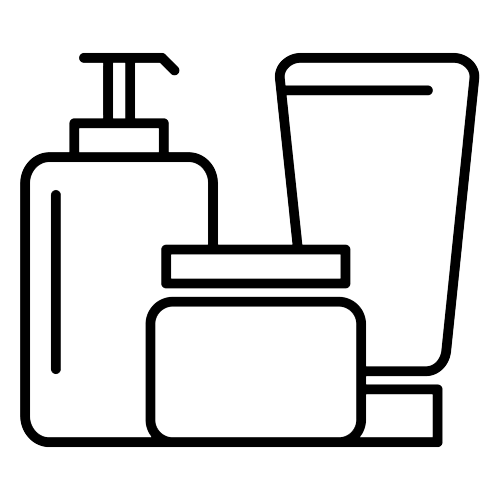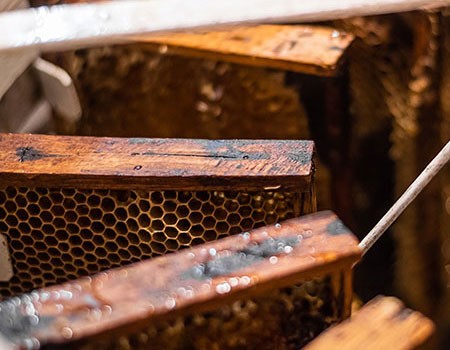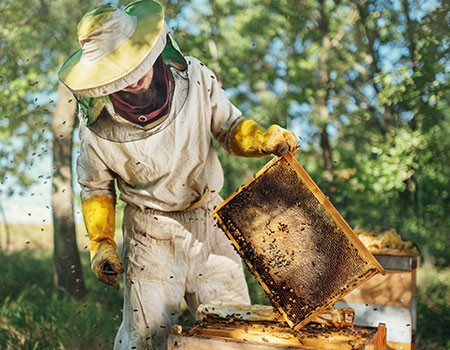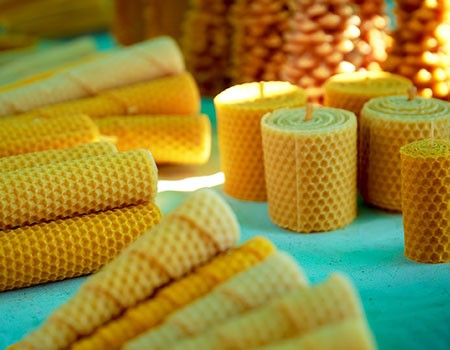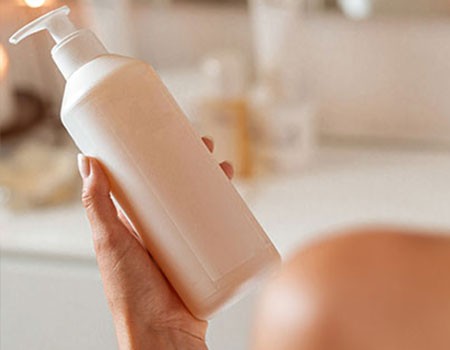As a natural substance, beeswax offers a very wide range of possible applications. In addition to its use as candle wax, it is also used as a sealant and as a component in the manufacture of cosmetic products such as creams, ointments and lipsticks. In the technical sector, beeswax is used, for example, as a ski wax, impregnating agent, and for the production of wax paints or plant protection products. This makes it an excellent alternative to petroleum- or lignite-based waxes.
In the online store of chemiekontor.de you can obtain beeswax for the cosmetic sector and candle production as well as beeswax that is specially adapted to the requirements of the pharmaceutical industry.
Application areas
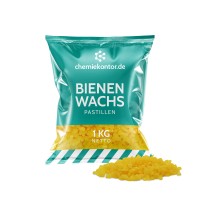
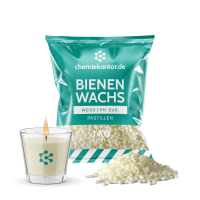




What is beeswax?
Beeswax is a product of the honey bee, with which it builds its honeycombs to store mainly honey or eggs. In the course of honey harvesting, the honeycomb remains and can be processed into wax. It is therefore a natural substance of animal origin.
- Cosmetic
Our cosmetic beeswax is a mixture of pure wax, fatty acids and hydrocarbons and is mainly suitable for use in the cosmetic industry. It is the yellowish wax (Cera flava), which has a warm hue and pleasant natural fragrance compared to the bleached wax (Cera alba). - Pharmaceutical
Our pharmaceutical beeswax impresses with its special purity and is used in medicine, pharmacy and high-quality natural products. It has been proven that the yellow unbleached beeswax (Cera flava) has a high protective effect and provides the skin with particularly long-lasting moisture.
Beeswax: formation, harvesting and refining
Honey bees form their combs in the beehive from individual wax scales, with which they raise the central walls. The beeswax is produced in 8 special abdominal glands of the insects, which secrete the wax from it. Initially, the narrow platelets secreted appear pure white. However, the wax later acquires its typical yellow color through kneading with propolis, other glandular secretions and flower pollen, which contain the coloring substance carotene.
For honey harvesting, individual combs are removed, freed from the honeycomb lid and finally emptied with the aid of a centrifuge. Both the honeycomb lid and the empty comb can then be cleaned and processed further. To do this, beekeepers place the soft lid in a screw press, for example, to separate the honey and wax.
They then melt the wax using a sun wax melter or steam wax melter. It is then cleaned in a water bath at a temperature of 75-80 °C. Due to the different density of water and wax, the dirt particles sink to the bottom and the pure substance rises to the top - leaving behind the clean, light-colored beeswax. Alternatively or additionally, beekeepers use classical filtration with the aid of sieves.
Beeswax has a firm consistency in its normal state, but can be kneaded a little at around 20 °C. It is also a very soft material. It consists partly of fatty acids, so it is not soluble in water. For this reason, it is often used to make impregnating agents that protect shoes or wood from moisture, for example. In principle, beeswax can be poured into any mold. In most cases, however, you get it as pastilles or platelets.
Depending on whether it is bleached or natural beeswax, it has a whitish or yellow color. The pleasant scent of honey, combined with its air-permeable composition, makes it an optimal ingredient for cosmetic and pharmaceutical products.
What is rapeseed oil in the refined variant used for?
Rapeseed oil in the refined variant is used in particular for the preparation of dishes. It is the most popular cooking oil in this country due to its many positive properties and is used in the following preparations, among others:
- the protection and separation of food products
- the firming of cosmetic products
- the sealing of cosmetic products
- impregnation of vulnerable surfaces
- Skin care
- The production of new wax medium walls
- reduction of resistance of skis or snowboards on snow
- production of candles
- the production of wax cloths
Beeswax in the cosmetic field
Many cosmetic products contain beeswax. There are several reasons for this: Creams, soaps and co. get their desired consistency from the solid substance, protect by sealing and care thanks to beneficial ingredients. Last but not least, the soothing scent is ideal for cosmetic applications - but also for candles, which are also made from the wax.
Beeswax in the pharmaceutical sector
Beeswax also plays a role in the pharmaceutical sector, especially for the production of ointments, pastes or lotions. This is because the wax coats affected areas of skin with an air-permeable protective layer that keeps bacteria or impurities out. On top of that, beeswax has some caring properties such as supplying moisture.
Buying beeswax for cosmetics and pharmaceutical products wholesale - the most frequently asked questions
Our beeswax usually comes from Germany or the European Union and is GMO-free. This means that neither the bees nor the wax have been genetically modified.
Beeswax is used as an additive and adjuvant in the food, cosmetics, candle, clothing, sports and pharmaceutical industries, among others.
The density of beeswax is between 0.95 and 0.96 g/cm3.
At chemiekontor.de you can buy cosmetic beeswax in packages of 250 g, 500 g, 1 kg, 5 kg and 25 kg. Pharmaceutical beeswax you can get in the sizes of 1 kg, 5 kg and 20 kg.
Beeswax melts at a temperature of approximately 62 °C.
We usually have beeswax in stock ready for shipment, so the delivery time is around 3 to 5 working days.
Beeswax is not a hazardous substance, so there are no safety instructions to follow and no hazard labeling is required.
The CAS number for pharmaceutical beeswax is 8012-89-3.
Yes, you can use beeswax to make candles - both pillar and glass candles. It is best to buy cosmetic beeswax for this purpose.
What are the advantages of beeswax?
What are the properties of refined beeswax?
1 | Environmentally friendly
Beeswax is a natural raw material that remains free of artificial additives even after refinement. This means that the wax can be completely biodegraded on the one hand or 100% recycled on the other. Especially compared to petroleum- and lignite-based waxes, beeswax is therefore considered a very environmentally friendly material that is significant for numerous economic sectors.
2 | Versatile
Due to several positive properties, beeswax can be used in a variety of ways. These include ease of refinement and processing, delicate consistency, even burning, and a natural and pleasant scent. In addition, it combines well with other substances in both the pharmaceutical and cosmetic fields.
3 | High quality
Compared to other waxes, wax from the honey bee can be cleaned with extremely little effort and refined without artificial additives. Due to its low melting temperature, it can also be processed much more easily and in a way that conserves resources - into candles, center panels or wax cloths. Another quality feature is the long and constant burning of beeswax.


